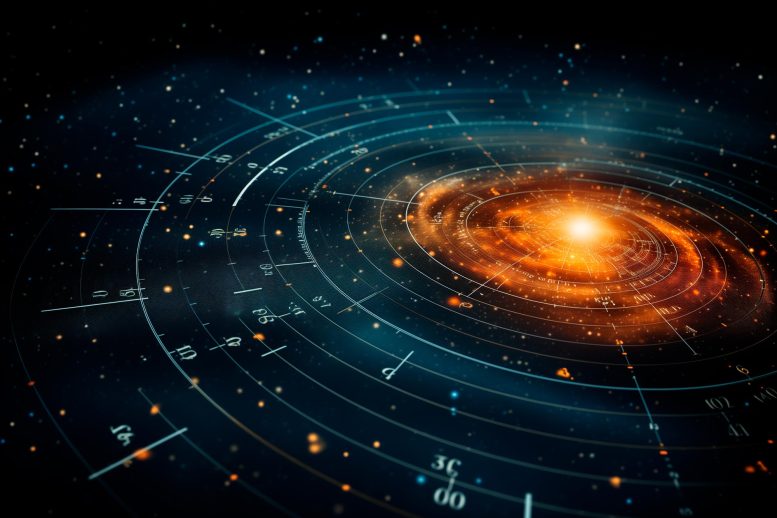
The James Webb Space Telescope is revolutionizing our understanding of galaxy evolution in the early universe through redshift analysis and advanced imaging techniques, leading to significant discoveries and emphasizing the need for precise spectroscopic data. Credit: SciTechDaily.com
Using redshift and photometry, NASA’s James Webb Space Telescope is uncovering the secrets of early galaxies, demonstrating the need for precise spectral data in understanding the universe’s history.
One of NASA’s James Webb Space Telescope’s science goals is to understand how galaxies in the early universe formed and evolved into much larger galaxies like our own Milky Way. This goal requires that we identify samples of galaxies at different moments in the universe’s history to explore how their properties evolve with time.
We asked Micaela Bagley, a postdoctoral fellow at the University of Texas at Austin, to explain how astronomers analyze light from distant galaxies and determine “when in the universe’s history” we are observing them.
“Light takes time to travel through space. When light from a distant galaxy (or any object in space) reaches us, we are seeing that galaxy as it appeared in the past. To determine the ‘when’ in the past, we use the galaxy’s redshift.
“Redshift tells us how long the light has spent being stretched to longer wavelengths by the expansion of the universe as it travels to reach us. We can calculate the redshift using features in the galaxy’s spectrum, which is an observation that spreads out the light from a target by wavelength, essentially sampling the light at very small intervals. We can measure the emission lines and spectral breaks (abrupt changes in the light intensity at specific wavelengths), and compare their observed wavelengths with their known emitted wavelengths.
“One of the most efficient ways to identify galaxies is through imaging, for example with the observatory’s NIRCam (Near-Infrared Camera) instrument. We take images using multiple filters to collect the object’s light in several different colors. When we measure a galaxy’s photometry, or how bright it is in an image, we’re measuring the brightness of the object averaged across the full range of wavelengths transmitted by the filter. We can observe a galaxy with NIRCam’s broadband imaging filters, but there is a lot of detailed information hidden within each single measurement for every 0.3–1.0 microns in wavelength coverage.
“Yet we can start to constrain the shape of a galaxy’s spectrum. The spectrum’s shape is affected by several properties including how many stars are forming in the galaxy, how much dust is present within it, and how much the galaxy’s light has been redshifted. We compare the measured brightness of the galaxy in each filter to the predicted brightness for a set of galaxy models spanning a range of those properties at a range of redshifts. Based on how well the models fit the data, we can determine the probability that the galaxy is at a given redshift or ‘ moment in history.’ The best-fitting redshift determined through this analysis is called the photometric redshift.
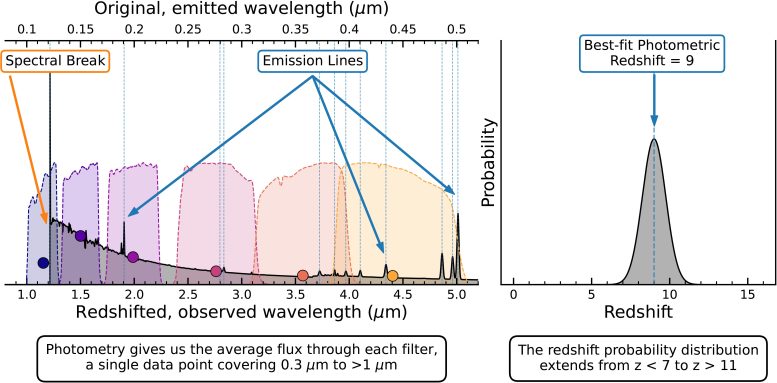
An illustration of measuring a photometric redshift using six broadband imaging filters (left panel). A model galaxy spectrum with a strong spectral break and several emission lines is shown in gray. The wavelength at which the light was emitted and observed is listed along the top and bottom, respectively. The light has been redshifted (or stretched out) by a factor of 10. The NIRCam filter transmissions and wavelength coverages are shown by the colored shaded regions. We measure the average flux in each filter (circles) and fit these six data points with different galaxy models at a range of redshifts to determine the probability that the galaxy is at each redshift. The galaxy has a best-fit photometric redshift of 9 (when the universe was 550 million years old), but the probability distribution (right panel) covers the redshift range of 7-11 (when the universe was between 420 to 770 million years old.) Credit: Micaela Bagley
“In July 2022, teams used NIRCam images from the CEERS Survey to identify two galaxies with photometric redshifts greater than 11 (when the universe was less than 420 million years old.) Neither of these objects were detected by NASA’s Hubble Space Telescope observations in this field because they are either too faint or are detectable only at wavelengths outside of Hubble’s sensitivity. These were very exciting discoveries with the new telescope!
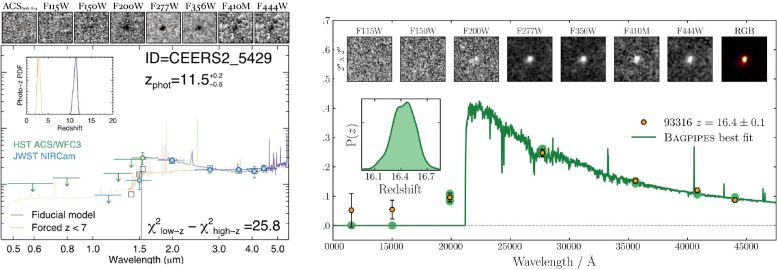
Two galaxies discovered in early NIRCam imaging with photometric redshifts of 11.5 and 16.4 (when the universe was about 390 and 240 million years old, respectively). For each galaxy, the teams show image cutouts in all available filters along the top, the observed photometry, the best-fitting galaxy model, and the photometric redshift probability distribution as an inset. Credit: Top panel – Finkelstein et al. (2023) ; Bottom panel – Donnan et al. (2023) .
“However, photometric redshift of a galaxy is somewhat uncertain. For example, we may be able to determine that a spectral break is present in a filter, but not the precise wavelength of the break. While we can estimate a best-fit redshift based on modeling the photometry, the resulting probability distribution is often broad. Additionally, galaxies at different redshifts can have similar colors in broadband filters, making it difficult to distinguish their redshifts based only on photometry. For example, red, dusty galaxies at redshifts less than 5 (or when the universe was 1.1 billion years old or older) and cool stars in our own galaxy can sometimes mimic the same colors of a high-redshift galaxy. We therefore consider all galaxies that are selected based on their photometric redshifts to be high-redshift candidates until we can obtain a more precise redshift.
“We can determine a more precise redshift for a galaxy by obtaining a spectrum. As illustrated in the following figure, our calculation of the redshift probability distribution improves as we measure the photometry of a galaxy in ever finer wavelength steps. The probability distribution narrows as we move from using broadband filters for imaging (top) to a larger number of narrower filters (middle), to a spectrum (bottom). In the bottom row we can start to key off specific features like the spectral break on the far left and emission lines to obtain a redshift probability distribution that is very precise – a spectroscopic redshift.
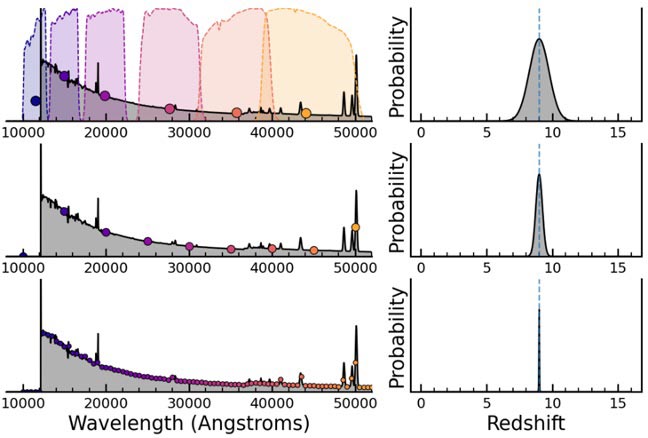
An illustration of how the redshift probability distribution (right panels) narrows as we measure the photometry of a galaxy (left panels) in ever finer wavelength steps. Credit: Micaela Bagley
“In February 2023, the CEERS teams followed up their high-redshift candidates with observatory’s NIRSpec (Near-Infrared Spectrograph) instrument to measure precise, spectroscopic redshifts. One candidate (Maisie’s Galaxy) has been confirmed to be at redshift 11.4 (when the universe was 390 million years old), while the second candidate was discovered to actually be at a lower redshift of 4.9 (when the universe was 1.2 billion years old.)
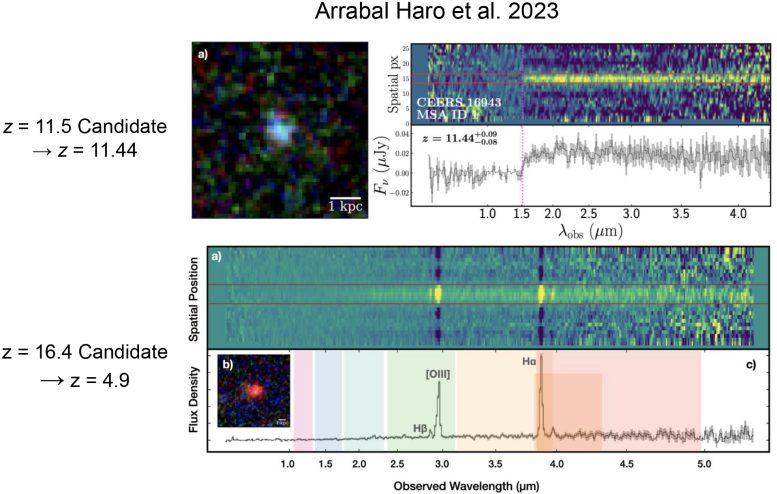
Spectroscopic observations with the NIRSpec instrument of the two galaxy candidates at redshifts 11.5 and 16.4. The top row shows Maisie’s Galaxy at left, which is confirmed to be at a redshift of 11.44 (or when the universe was about 390 million years old). This redshift is based on the detection of the spectral break marked by the dotted vertical red line in right figure in the upper row in the NIRSpec spectrum. The bottom row shows the candidate from Donnan et al. (2023), which is found to be at a redshift of 4.9 from strong doubly ionized oxygen ([OIII]) and hydrogen (Hα) emission lines. Credit: Figures 2 and 3 from Arrabal Haro et al. (2023)
About the Author
Micaela Bagley is a postdoctoral fellow at the University of Texas at Austin and a member of CEERS. They study galaxy formation and evolution in the early universe. Micaela is also responsible for processing all the NIRCam images for the CEERS team.





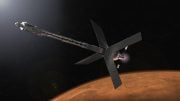



As a now senior lay discoverer who learned of the Doppler effect and redshift by the time I graduated high school, I’ve been commenting on this subject on SciTechDaily.com and elsewhere for some time now (e.g., https://scitechdaily.com/the-great-galactic-misconception-uncovering-true-distances-in-space/#comment-829065), of how gravity is actually locally generated pulsating angular lines of attractive force radiating out across the universe in generally spherical fields of declining density and strength, in accordance with the inverse square law of attraction.
As counterintuitive as it is, the greatest difference between my version and the establishment version (factoring-in published findings of gravity affecting photons; e.g., “gravity lensing”) I find that photons of light accelerate (blue shift) on individual lines of gravity force when leaving their sources and decelerate (red shift) when arriving in the increasingly dense fields of our sun and earth, which may substantially alter the results of calculating the age and size of the universe. Well beyond my ability and available resources to make the calculations, I now wonder just how many differences there are in ages and distances between cosmic objects as per the two versions of gravity?